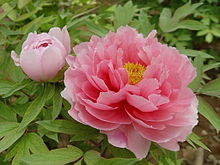Paeonia suffruticosa
| Paeonia suffruticosa | |
|---|---|
 |
|
| Scientific classification | |
| Kingdom: | Plantae |
| (unranked): | Angiosperms |
| (unranked): | Eudicots |
| (unranked): | Core eudicots |
| Order: | Saxifragales |
| Family: | Paeoniaceae |
| Genus: | Paeonia |
| Species: | P. suffruticosa |
| Binomial name | |
|
Paeonia suffruticosa Andrews |
|
Paeonia suffruticosa is a name used for a group of culture varieties of tree peonies that are the result of hybridisation with species exclusively belonging to the subsection Vaginatae. The common name used in China is 牡丹 (mu dan). Plants belonging to this group have been cultivated for millennia in China, initially only as a source of traditional Chinese medicine, particularly the skin of its roots is used as 牡丹皮 (mu dan pi). Already early on the plant was also cultivated for its ornamental value, and it is highly revered in Chinese culture.
Paeonia suffruticosa is the name used for most tree peony cultivars, but is not a naturally occurring species. So it can be regarded as the name for a man-made hybrid swarm. Genetic analysis has shown that five species of the subsection Vaginatae together make up the parentage of the tree peony cultivars created before World War II. In over three quarters of the almost fifty studied cultivars, the DNA of their chloroplasts is identical to that in Paeonia cathayana, indicating that this species is the original maternal parent. Almost all of the remaining cultivars has chloroplast DNA identical to that in P. qiui, and rarely from P. ostii and partially from Paeonia rotundiloba. In the nuclear DNA however, homology with Paeonia rockii is largest, with lesser contributions from P. qiui, P. ostii, P. cathayana and P. jishanensis. Paeonia decomposita is the only species from the Vaginatae that has not contributed to these cultivars.
Crossbreeding of yellow-flowered P. delavayi with traditional double-flowered P. suffruticosa cultivars by Émile Lemoine has led to the introduction of the color yellow into the cultivated double-flowered tree-peonies. These hybrids are known as the P. ×lemoinei-group, and include double-flowered "Chromatella" (1928), "Alice Harding" (1935) and semidouble-flowered "Sang Lorraine" (1939). In 1948 horticultulturist Toichi Itoh from Tokyo used pollen from "Alice Harding" to fertilize the herbaceous P. lactiflora "Katoden", which resulted in a new category of peonies, the Itoh or intersectional cultivars. These are herbaceous, have leaves like tree peonies, with many large flowers from late spring to early autumn, and good peony wilt resistance. Some of the early Itoh cultivars are "Yellow Crown", "Yellow Dream", "Yellow Emperor" and "Yellow Heaven".
...
Wikipedia
